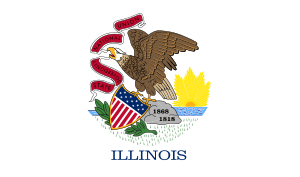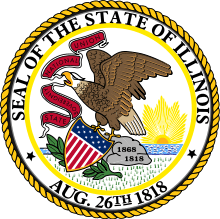Illinois gubernatorial election, 2006

|
|
|
|
|

|
| County Results |
|
|
| Elections in Illinois |
|---|
 |
|
Presidential elections |
|---|
|
|
|
U.S. Senate elections |
|---|
|
|
|
U.S. House elections |
|---|
|
|
|
Special elections |
|---|
|
|
|
|
Gubernatorial elections |
|---|
|
|
|
State Senate elections |
|---|
|
|
|
State House of Representatives elections |
|---|
|
|
|
General elections |
|---|
|
|
|
|
|
|
Mayoral elections |
|---|
|
|
|
Council elections |
|---|
|
|
|
|
The Illinois gubernatorial election of 2006 occurred on November 7, 2006. The Governor of Illinois, Democrat Rod Blagojevich, won re-election for a four-year term scheduled to have ended on January 10, 2011. However, Blagojevich was impeached and convicted in 2009. Many observers expected the race to be close, especially considering the polling,[1] which has shown Governor Blagojevich had a high disapproval rating. However, the Republicans fared poorly in elections since 2002 due to scandals involving prior Governor George Ryan, as well as changing demographics in the state as a whole (see blue state).
Republican primary
Candidates
Campaign
On November 7, 2005, Topinka announced that she would not seek re-election as state treasurer — instead, she entered the gubernatorial primary, hoping to challenge Democratic Governor Rod Blagojevich. The Republican primary was deeply divisive; her tenure as Party Chairman destroyed her support from the conservative wing of her party, and it was feared that her pro-choice and positive gay rights positions would be detrimental to her standing with the same conservatives. In December she announced that she would join forces with DuPage County State's Attorney Joe Birkett as a candidate for Lieutenant Governor of Illinois.
In February 2006, the candidates for the Republican nomination for Illinois Governor began running their first TV ads for the March statewide primary election. Rival candidate Ron Gidwitz's advertisements, attacking Topinka, were rebuked in the same week by the Illinois Republican Party: "In an unprecedented action, the Illinois Republican Party has officially rebuked the Gidwitz campaign for this ad because the Party found that the ad violates the Party's "Code of Conduct", which was enacted to police proper conduct among Republican candidates."
Later in February, candidate Jim Oberweis, another rival for the Republican Gubernatorial nomination, started a series of attack ads for television markets, against Topinka, that were even more widely criticized, mostly for using "fake" headlines on the images of actual Illinois newspapers. These ads, like Gidwitz's ads, also came under review by the Illinois Republican Party. Because of the controversy generated, several television stations withdrew Oberweis's ads. A number of media outlets reported that Oberweis received a significant absolute number of write-in votes in the November general election, and he spontaneously re-appeared in some polls in October 2006 at up to 2 per cent,[2] all apparently without endorsement or co-ordination by the candidate or his organisation . . . the official count was 20 607 votes or a little over 0.59 per cent (see below); where this fits in terms of standard deviation and other normal curve statistics has not been published.
Results
Republican primary results[3]
| Party |
Candidate |
Votes |
% |
|
Republican |
Judy Baar Topinka |
280,701 |
38.15 |
|
Republican |
Jim Oberweis |
233,576 |
31.74 |
|
Republican |
Bill Brady |
135,370 |
18.40 |
|
Republican |
Ron Gidwitz |
80,068 |
10.88 |
|
Republican |
Andy Martin |
6,095 |
0.83 |
| Total votes |
735,810 |
100.00 |
Democratic primary
Candidates
Results
Democratic primary results[3]
| Party |
Candidate |
Votes |
% |
|
Democratic |
Rod Blagojevich (inc.) |
669,006 |
70.84 |
|
Democratic |
Edwin Eisendrath |
275,375 |
29.16 |
| Total votes |
944,397 |
100.00 |
General election
Candidates
On ballot
Write-ins
Polling

| Source |
Date |
Blagojevich (D) |
Topinka (R) |
Whitney (G) |
Remainder |
| Survey USA |
November 2, 2006 |
45% |
37% |
14% |
4% |
| Survey USA |
October 23, 2006 |
44% |
34% |
14% |
8% |
| Rasmussen |
October 19, 2006 |
44% |
36% |
9% |
11% |
| Zogby/WSJ |
October 16, 2006 |
47.1% |
33.2% |
11.3% |
8.4% |
| Glengariff Group |
October 15, 2006 |
39% |
30% |
9% |
22% |
| Tribune/WGN-TV |
October 11, 2006 |
43% |
29% |
9% |
19% |
| Survey USA |
September 20, 2006 |
45% |
39% |
7% |
9% |
| Rasmussen |
September 13, 2006 |
48% |
36% |
Omitted |
16% |
| Sun-Times/NBC5 |
September 12, 2006 |
56% |
26% |
3% |
15% |
| Tribune/WGN-TV |
September 11, 2006 |
45% |
33% |
6% |
16% |
| Zogby/WSJ |
September 11, 2006 |
46.5% |
33.6% |
Omitted |
19.9% |
| Research 2000 |
August 31, 2006 |
47% |
39% |
2% |
12% |
| Zogby/WSJ |
August 28, 2006 |
44.8% |
37.6% |
Omitted |
17.6% |
| Rasmussen |
August 10, 2006 |
45% |
37% |
Omitted |
18% |
| Survey USA |
July 25, 2006 |
45% |
34% |
Omitted |
21% |
| Zogby/WSJ |
July 24, 2006 |
44.4% |
36.4% |
Omitted |
19.2% |
| Rasmussen |
July 13, 2006 |
45% |
34% |
Omitted |
21% |
| Zogby/WSJ |
June 21, 2006 |
41.1% |
37.5% |
Omitted |
21.4% |
| Glengariff Group |
June 1–3, 2006 |
41% |
34% |
|
25% |
| Survey USA |
May 23, 2006 |
43% |
37% |
Omitted |
20% |
| Rasmussen |
April 24, 2006 |
38% |
44% |
Omitted |
18% |
| Rasmussen |
March 31, 2006 |
41% |
43% |
Omitted |
16% |
| Rasmussen |
February 25, 2006 |
42% |
36% |
Omitted |
22% |
| Rasmussen |
February 7, 2006 |
37% |
48% |
Omitted |
15% |
| Research 2000 |
January 22, 2006 |
45% |
37% |
|
18% |
Results
Illinois gubernatorial election, 2006[4]
| Party |
Candidate |
Votes |
% |
± |
|
Democratic |
Rod Blagojevich (inc.) |
1,736,731 |
49.79% |
-2.40% |
|
Republican |
Judy Baar Topinka |
1,369,315 |
39.26% |
-5.81% |
|
Green |
Rich Whitney |
361,336 |
10.36% |
|
|
Write-ins |
Various candidates |
20,607 |
0.59% |
|
| Plurality |
367,416 |
10.53% |
+3.41% |
| Turnout |
3,487,989 |
|
|
|
Democratic hold |
Swing |
|
|
Blagojevich was declared the winner by 10:00 p.m.
Green Party Establishment
The Green Party became an established political party statewide, according to Illinois state election law, when Rich Whitney received more than 5% of the total vote for Governor. This status provides the party with several new advantages, such as lower signature requirements for ballot access, primary elections, free access to additional voter data, the ability to elect precinct committeemen, run a partial slate of candidates at any jurisdictional level, and slate candidates without petitioning. The only other statewide established political parties are the Democratic and Republican parties. It is rare for a new political party to become established statewide in Illinois, the last to do so being the Solidarity Party in 1986 and the Progressive Party before that.
See also
References
External links
|
|---|
|
U.S.
Senate | |
|---|
|
U.S.
House |
- Alabama
- Alaska
- Arizona (1st, 8th)
- Arkansas
- California
- Colorado (4th, 5th, 7th)
- Connecticut (4th)
- Delaware
- Florida (5th, 8th, 9th, 16th)
- Georgia (4th, 8th)
- Hawaii
- Idaho
- Illinois (6th, 8th, 10th, 11th, 19th)
- Indiana (7th)
- Iowa
- Kansas
- Kentucky
- Louisiana (2nd)
- Maine
- Maryland
- Massachusetts
- Michigan (8th)
- Minnesota (5th, 6th, 8th)
- Mississippi
- Missouri
- Montana
- Nebraska (3rd)
- Nevada (2nd)
- New Hampshire
- New Jersey (5th, 13th)
- New Mexico
- New York (13th, 20th, 29th)
- North Carolina
- North Dakota
- Ohio (2nd, 13th)
- Oklahoma
- Oregon
- Pennsylvania
- Rhode Island
- South Carolina
- South Dakota
- Tennessee
- Texas (22nd)
- Utah
- Vermont
- Virginia (2nd)
- Washington
- West Virginia (2nd)
- Wisconsin (8th)
- Wyoming
|
|---|
|
| Governors | |
|---|
|
| Mayors | |
|---|
|
| States | |
|---|
|
|---|
|
| Presidential (since 1832) | |
|---|
|
| Senatorial (since 1990) | |
|---|
|
| Gubernatorial (since 1990) | |
|---|
|
|
|
|---|
|
| Blagojevich Family | |
|---|
|
| Scandal | |
|---|
|
| Elections | |
|---|
|
| Related people | |
|---|





